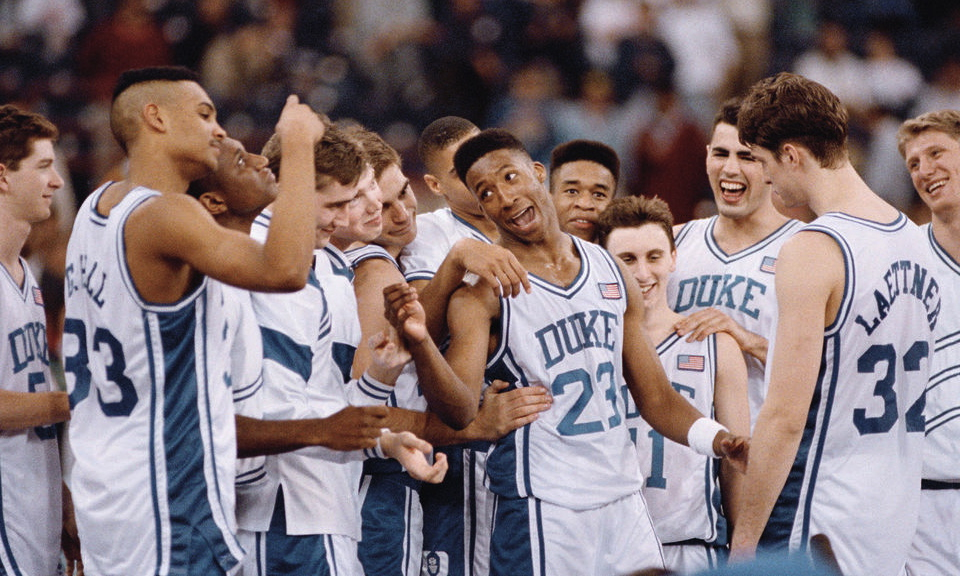Certainly, there is a great deal of excitement during the N.C.A.A. Tournament, especially when the lower seeds overcome the odds and wins. There is also a tremendous amount of information that players can absorb and add to their repertoires when the games are over. The upsets don’t occur by happenstance but because the underdogs create a solid gameplan – usually based on a favourable match-up or exploiting a team strength – and execute it effectively. Talent can be defeated with team play, tactics and tenacity.
(13) Princeton 43 – (4) U.C.L.A. 41
The Tigers stayed with the defending national champion Bruins by executing their offensive sets and playing tough defense. The 1995-96 U.C.L.A. were far more athletic and talented then their Ivy League counterparts but could never pull away during the game. The Princeton offense was disciplined and generated a high number of high percentage shots from lay-ups and three-point shots.
When it came down to the final possessions of the game, Princeton stuck with the same plan. The two guards on top remained patient and the others cut. Gabe Lewullis cut backdoor from the right wing but he wasn’t open so he exit cut back to the three-point line. At this point, the defender relaxed and Lewullis cut again, receiving a bounce pass for a lay-up.
The Tigers still had to play defense. When Toby Bailey caught the ball in the left corner, the defender ran him off the arc and forced him baseline. The awkward pull-up missed and Princeton completed one of the most memorable upsets in N.C.A.A. history.
(6) N.C. State 54 – (1) Houston 52 (1983)
North Carolina State and Jim Valvano entered the 1983 N.C.A.A. Tournament as a bubble team but won a series of close games in order to claim the championship. The team was persistent and played hard irrespective of the opponent or the score. The Wolfpack won a number of games in the tournament by a basket or less and came from behind several times.
Rather than play a tentative game and keep the ball away from Clyde Drexler and (H)Akeem Olajuwon, N.C. State played aggressively. The Wolfpack emulated Houston’s fast break style when it could and executed a deliberate half-court offense otherwise. They held the ball for the last 1:08 of the game before Dereck Whittenburg launched a long shot from the top of the key with seconds remaining.
It would be easy to be satisfied with that shot and settle for overtime if it missed by N.C. State’s run was based on a “never say die” attitude. Lorenzo Charles saw an opportunity, elevated above the seven-foot tall Olajuwon and dunked the airball as time expired.
(2) Duke 79 – (1) U.N.L.V. 77 (1991)
Duke had ample reasons to be pessimistic about their rematch with U.N.L.V. at the 1991 Final Four: suffering a thirty-point loss in the title game the year before and competing against a team who had not loss in forty-five games. Fans and observers may have been skeptical but the Blue Devils were positive about their chances during practice all week and throughout the game.
The previous year, Duke was overwhelmed by the Runnin’ Rebels and was never in the game but they adopted a more assertive attitude when they were given a second chance. The team protected the ball against U.N.L.V.’s pressure, drove the ball into the paint and used the length of the court. At the other end, Duke did not allow easy baskets, fouling when necessary to set a tone.
As the last minute of the game ticked away, Duke stayed in control, running their motion set. They did not allow the defense to rush their shot or force them to take an outside shot. Thomas Hill drove the ball inside and drew the help; this gave Christian Laettner room to crash the boards and draw the foul. U.N.L.V. still had time for one more shot but the Blue Devils closed the paint and Larry Johnson had to forgo his drive and pass to Anderson Hunt for a contested outside shot.
